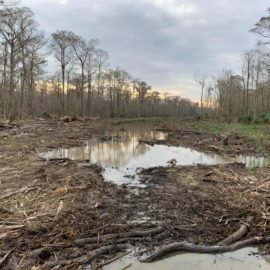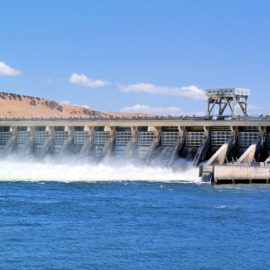
The Formosa Plant has been opposed, for good reasons, by many civic groups. The state did a quick pollution survey largely ignoring the minority communities. Now the Corps of Engineers will take a closer look.
Construction on an enormous $9.4 billion plastics plant proposed in St. James Parish must be delayed so the U.S. Army Corps of Engineers can do a more extensive and lengthy review of the facility’s impacts on the environment and nearby minority communities, a top Army official said Wednesday. Jaime A. Pinkham, acting assistant secretary of the Army for civil works, said the new review of the Formosa Plastics complex would have a particular focus on any environmental justice concerns. The proposed plant would be located near the largely African American community of Welcome on the parish’s west bank. In a two-page memo, Pinkham didn’t offer many details for the reasons behind the decision. But the Corps of Engineers already acknowledged to a federal judge late last year that an earlier, less intensive review for the permit had errors in part of its analysis. At the time, the Corps had suspended that original, flawed permit, which would allow Formosa to fill in wetlands on the more than 2,300-acre site along the Mississippi River. But it has become a lightning rod for some other local leaders and environmental and community groups, who have criticized its toxic air emissions, risk of accidental release of plastic pellets, the ramp-up in plastics production it represents, and its proximity to antebellum graves that may hold deceased slaves.
theadvocate.com
The Formosa Plant is not a stranger to opposition. It is one of many industrial plants in the area and there is a higher incidence of cancer, leading to its being termed Cancer Alley.
The project, announced in spring 2018, has already hit other slowdowns because of high Mississippi River water and state and federal litigation. Since the Corps of Engineers’ suspension of the Formosa permit in November, all sides of the intense debate over the plant have been waiting to see what the agency’s next step would be. During that time, months of public pressure built on the new Biden administration from environmental groups, political leaders in other states, and a United Nations investigator, all of whom argued that the huge complex would have a disproportionate impact on minority communities located nearby and already breathing poor air. The UN investigator charged it was an example of “environmental racism.” The decision was announced Wednesday in a Tweet from Pinkham, the Army assistant secretary. “As a result of information received to date and my commitment for the Army to be a leader in the federal government’s efforts to ensure through environmental analysis and meaningful community outreach, I conclude an EIS process is warranted to thoroughly review areas of concern, particularly those with environmental justice implications,” Pinkham wrote in a two-page memo dated Aug. 18. An “EIS” is an “environmental impact statement,” a more in-depth review than what the agency previously did for the Formosa project. Pinkham added that the review he was ordering the Corps of Engineers to do would “assess the proposed project’s potential impacts on the quality of the human environment in the region and to support its final decision to modify, reinstate, or revoke the permit.” Pinkham’s memo says that the new review process would “provide opportunities for voices to be heard in an open, transparent, and public way.” A Corps spokesman in Washington, D.C., didn’t immediately return a call for comment Wednesday.
Environmental groups responded with cheers and happiness. The mention of personal voices and the focus on the communities is welcome.
Environmental and community groups who have been fighting the complex in court and public meetings and through media campaigns hailed the decision Wednesday. Meanwhile, a spokeswoman for the local Formosa affiliate said the company retained an “unwavering commitment” to the state and parish but was trying to find out more about what the new analysis would entail. “The tweet and accompanying letter from the Acting Assistant Secretary of the Army posted today online provide little detail on EIS procedure the Corps intends to use in its additional evaluation of the project,” Janile Parks, spokeswoman for FG LA LLC, said Wednesday. “As a result, the company will continue to work with the Corps as we receive more guidance on the additional evaluation and has no further comment at this time.” Sharon Lavigne, a St. James Parish native who formed Rise St. James and joined with an array of environmental groups to fight the complex, said the Corps of Engineers “has finally heard our pleas and understands our pain” and said she was hopeful Formosa would pull out. “Nobody took it upon themselves to speak for St. James Parish until we started working to stop Formosa Plastics. Now the world is watching this important victory for environmental justice,” she said in a joint statement.
Opposition has been strong and from a variety of areas both local, national, and world wide.
Rise St. James was one of a handful of local and national groups who challenged the first Corps permit in federal court. That legal action sent the Corps of Engineers on the path of suspending and reviewing its previous decision-making, which was originally reached in September 2019 under former President Donald Trump. Since then, President Joe Biden has taken office and promised to take environmental justice concerns into more consideration as federal agencies review new industrial proposals. U.S. Rep. Troy Carter, D-New Orleans, wrote Biden’s EPA administrator late last week urging him to provide third-party monitoring of the river region’s nearly 150 industrial facilities and to take other steps to better understand their impact on minority communities. The request came as Carter, whose river region district includes St. James Parish, criticized self-monitoring of emissions. On Wednesday, in reaction of the Formosa decision, he said he applauded “our regulatory agencies for doing their job to fully examine and ensure the highest degree of safety possible, while allowing the voices of the community to be heard.” He also added that “industry and community can coexist.”
This is not the end. The EIS will be done and another decision made.
The decision to do an EIS doesn’t kill the project from a regulatory perspective. But Pinkham’s memo doesn’t offer any guarantee of an outcome. The review will likely require that the Corps and FG LA do a far more extensive analysis of the plant’s emissions and impact on African American neighborhoods closest to the facility and whether other sites or a smaller plant would be a better option. In November, the Corps told a federal judge that its “alternatives analysis” for the original Formosa permit needed reevaluation, so it had been suspended. Five possible plant sites in Ascension Parish, the Corps acknowledged, had been excluded due to an erroneous assumption about air quality limits in that parish. Environmental groups had pointed out that same oversight, among others, they claimed, in the federal litigation over the Corps permit. In the tweet, Pinkham wrote that Formosa’s permit would remained suspended until the new review is finished and the Corps reaches a final decision.
A victory and one that should be recognized. The final decision will be the final one, hopefully. Rep. Carter says industry and the community can live together but not an industry that kills or sickens the community.



